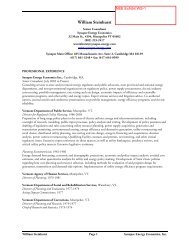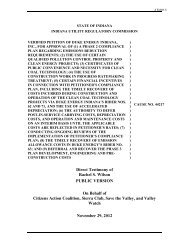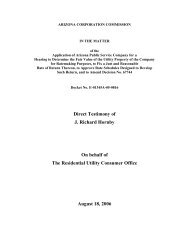Best Practices in Energy Efficiency Program Screening - Synapse ...
Best Practices in Energy Efficiency Program Screening - Synapse ...
Best Practices in Energy Efficiency Program Screening - Synapse ...
Create successful ePaper yourself
Turn your PDF publications into a flip-book with our unique Google optimized e-Paper software.
These <strong>in</strong>clude: fully account<strong>in</strong>g for other program impacts (OPIs) 1 where appropriate;<br />
properly estimat<strong>in</strong>g avoided costs; us<strong>in</strong>g the most appropriate discount rate; captur<strong>in</strong>g<br />
spillover effects; fully account<strong>in</strong>g for the risk benefits of energy efficiency; and more. All<br />
of the best practices we recommend are be<strong>in</strong>g applied today <strong>in</strong> at least one state, and<br />
sometimes <strong>in</strong> many states. However, there are few states, if any, that apply all of the<br />
best practices recommended here. In the f<strong>in</strong>al section of this Executive Summary we<br />
discuss the key issues to consider <strong>in</strong> decid<strong>in</strong>g which test to use <strong>in</strong> screen<strong>in</strong>g energy<br />
efficiency programs.<br />
We note at the outset that one of the chief considerations <strong>in</strong> screen<strong>in</strong>g energy efficiency<br />
programs is to ensure that the programs will reduce energy costs to customers. <strong>Energy</strong><br />
efficiency offers a variety of benefits to customers and to society as a whole, some of<br />
which have important public policy implications. However, <strong>in</strong> screen<strong>in</strong>g energy efficiency<br />
resources it is critical to acknowledge that for many key stakeholders – e.g., legislators,<br />
regulators, and consumer advocates – the benefit of reduc<strong>in</strong>g energy costs and reduc<strong>in</strong>g<br />
customers’ bills is paramount.<br />
Treatment of Other <strong>Program</strong> Impacts<br />
Other program impacts are those costs and benefits that are not part of the cost, or the<br />
avoided cost, of energy. OPIs fall <strong>in</strong>to three categories:<br />
Utility-perspective OPIs <strong>in</strong>clude, for example, reduced customer arrearages and<br />
reduced bad debt write-offs.<br />
Participant-perspective OPIs <strong>in</strong>clude, for example, improved health, <strong>in</strong>creased<br />
safety, other fuel sav<strong>in</strong>gs, reduced ma<strong>in</strong>tenance costs, and <strong>in</strong>creased comfort.<br />
Many of these participant-perspective OPIs are especially significant for low<strong>in</strong>come<br />
customers.<br />
Societal-perspective OPIs <strong>in</strong>clude, for example, reduced environmental impacts<br />
and reduced costs of provid<strong>in</strong>g health care.<br />
These OPIs should be <strong>in</strong>cluded <strong>in</strong> cost-effectiveness tests for<br />
which the relevant costs and benefits are applicable. The<br />
primary rationale for <strong>in</strong>clud<strong>in</strong>g OPIs is to ensure that the tests<br />
are <strong>in</strong>ternally consistent. This is especially important <strong>in</strong> the<br />
application of the TRC test. By def<strong>in</strong>ition, this test <strong>in</strong>cludes<br />
the participant cost of the energy efficiency measures, which<br />
can be quite large <strong>in</strong> many cases. In order for the TRC test to<br />
be <strong>in</strong>ternally consistent, it must also <strong>in</strong>clude the participant<br />
benefits from the energy efficiency measures, <strong>in</strong>clud<strong>in</strong>g OPIs.<br />
Exclud<strong>in</strong>g the participant-perspective OPIs from the TRC test<br />
results <strong>in</strong> cost-effectiveness outcomes that are skewed<br />
| 2 <strong>Best</strong> <strong>Practices</strong> <strong>in</strong> <strong>Energy</strong> <strong>Efficiency</strong> <strong>Program</strong> Screen<strong>in</strong>g | www.nhpci.org<br />
The primary rationale for<br />
<strong>in</strong>clud<strong>in</strong>g other program<br />
impacts is to ensure that the<br />
tests are <strong>in</strong>ternally consistent.<br />
S<strong>in</strong>ce the TRC test <strong>in</strong>cludes<br />
the program participants’<br />
costs, it must also <strong>in</strong>clude the<br />
program participants’<br />
benefits.<br />
aga<strong>in</strong>st energy efficiency, under-<strong>in</strong>vestment <strong>in</strong> energy efficiency programs, and higher<br />
costs for utility customers on average.<br />
1 We use the term “other program impacts” to describe what are commonly referred to as non-energy<br />
impacts (NEIs) or non-energy benefits (NEBs). OPIs are those costs and benefits that are not part of the<br />
costs, or the avoided cost, of the energy provided by the utility that funds the efficiency program. In<br />
addition to non-energy impacts, OPIs also <strong>in</strong>clude “other fuel sav<strong>in</strong>gs,” which are the sav<strong>in</strong>gs of fuels<br />
that are not provided by the utility that funds the efficiency program.







